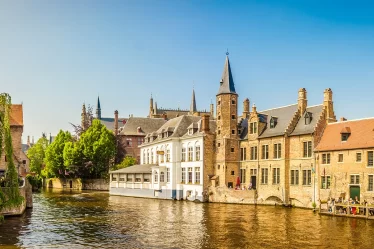
Lindau Island ,in the state of Bavaria in the south of Germany , is located southeast of Friedrichshafen , east of Lake Constance known as Bodensee . Connected to the land by two bridges, one of which is a railway bridge, Lindauis the largest island of the Bodensee .
The best way to explore the ancient and fascinating Lindau Island is to walk. Prepare to lose yourself in the small streets and paths surrounded by hundreds of years old houses. As you head towards the port, the magnificent views that you will encounter are a magnificent view stretching up to the coastline and the Austrian mountains. Only thirteen kilometers away, these mountains are closer than the Swiss mountains.

the historical city called Altstadt in Lindau ; It is located on the island called Insel Lindau . Lindau and Insel Lindau are connected by a bridge open to pedestrian and car traffic. There is also a railway bridge. The central station, called Hauptbahnhof , is also on the island.
Chirping Maximillianstrasse . Although this is a shopping street, it is a pedestrian zone closed to vehicular traffic. It is full of quaint cafes, small shops, historic buildings and cheerful tourists.
Lindau, which was declared a “Free Imperial City” by the Roman Empire in 1275, developed as a fishing town at first, but later turned into a trade center between two rich lands such as Swabia and Italy.

Lindauer Bote , a travel service center that operated between Germany and Italy in the eighteenth and nineteenth centuries, is located here. Goethe used the services of this company on his first trip to Italy in 1788 . A few years ago, this company was revived and started to organize thirteen-day trips to Italy. If you want to take advantage of this service, which is not done very often, it is useful to visit the tourist offices.
When the German empire was invaded by Napoleon’s revolutionary soldiers in the eighteenth century, Lindau also fell victim to political groups. It was controlled by the Austrian Empire until it fell under Bavarian control in 1805. The port was rebuilt in 1856.
Places to Visit in Linadu
- Altes Rathaus
- Marktplatz
- Barfüsserkirche
- Mangturm
- Lindau Lighthouse
- Der Bayerische Löwe
- Haus Zum Cavazzen
- St. Peter’s Church
- Wasserburg
Places to Visit in Linadu
1. Altes Rathaus

Altes Rathaus (Old Town Hall) , Lindau’s most beautiful and rarest historical building, was built between 1422 and 1436 in the middle of a vineyard. One hundred and fifty years later, in 1496, a fresco symbolizing the empire was built on the south façade by Emperor Maximillan, and it became a structure that changed its face. The building, which now houses offices, is closed to the public.
2. Marktplatz

Marktplatz , which is lined with very interesting structures that are still standing with their strength despite being old, are located in St. Stephen’s Church and St. It is home to important churches such as St. Mary’s Church.
Gothic St. Stephen’s Church is a simply decorated Lutheran temple. One of the most interesting features of the building, which dates back to the twelfth century and has been repaired many times, is the green ceiling decorations. Located right next to the church, St. Mary’s Church fascinates its visitors with its extraordinary baroque architecture.
3. Barfüsserkirche
The Barfüsserkirche (Church of the Barefoot Pilgrims), whose construction lasted from 1241 to 1270, serves as a theater today . The tickets for the shows held in the church, which is also home to the Puppet Theater called Lindauer Marionettenoper, can be bought at the box office next to it.
4. Mangturm

One of the oldest structures on the lake, the Mangturm is an ancient lighthouse from the thirteenth century. Although the building, located right on the corner of Lindau Harbor, is old, its brightly colored roof was completely repaired after a lightning strike in 1970, giving it a beautiful appearance.
5. Lindau Lighthouse

Germany’s southernmost lighthouse, with the Bavarian Lion, is waiting in the harbor like a watchman. Thirty-three meters high, the Lindau Lighthouse (Neuer Leuchtturm) overlooks Lake Constance. The lighthouse, whose construction was completed in 1856, was previously illuminated by the burning of oil.
The feature that distinguishes the lantern, which has been illuminated by electricity since 1936, is the huge clock placed on its exterior. The lighthouse, where photographers compete with each other to capture the shot they want, is one of the most elegant structures on the island in all its glory.
6. Der Bayerische Löwe
Der Bayerische Löwe (Bavarian Lion), one of the most striking symbols of which Lindau is proud, is a ten-meter giant lion sculpture made of Bavarian marble. Overlooking the lake majestically from the pedestal, the statue is located at the entrance to Lindau Harbour.
7. Haus Zum Cavazzen

Dating back to 1728 and the home of a wealthy merchant, Haus Zum Cavazzen (Lindau City Museum) is today considered one of the most beautiful buildings in the Bodensee Region.
The building, which is not surprising considering the rich decoration and frescoes inside, serves as a local historical museum. The museum, which hosts many exhibitions besides items made of glass and lead, paintings and furniture from the last five centuries, is located in the city center of Bavaria.
8. St. Peter’s Church

This enormous tenth-century Romanesque building is thought to be one of the oldest churches in the Bodensee District. st. Peter’s Church (Peterskirche), located on the inner side of the north wall and St. The frescoes depicting sections from Peter’s life and those who lost their lives in Auschwitz were made by Hans Holbein between 1465-1524.
The part of the church, which is on the list of places to visit in Lindau, is used as a pottery workshop in the past, and it served as a bell foundry in the past. Add the fairy-tale Diebstrum right next to the church to your must-see list. Look closely and you can see Rapunzel’s golden hair hanging down from the thirteenth-century tower, waiting for the prince to save her. When you follow the historical city wall behind the tower, you can reach the area where the people working in the construction of the bell live.
9. Wasserburg

Wasserburg , meaning water castle , is an island town six kilometers west of Lindau that was once a defensive fortress. st. Gallen Abbey in 924 and sold to the Fugger family of Augsburg by its owners, the counts of Montfort zu Tettnang. The Fugger family, who could not afford to build a chain bridge, had a simple road built instead.
The castle, which was captured by the Habsburgs in the nineteenth century, was seized by the Bavarian government in 1805. The building is known as one of the most photographed places on the Wasserburg Bodensee: the yellow staircase used by the church dignitaries; fisherman saint Georg Kirche and his dome; The small Malhaus Museum and, of course, the Schloss Wasserburg in the background , looks more like an oil painting than a photograph.
There are many restaurants, cafes and bars on Maximillianstrasse, which is the most lively street of the island. At the same time, you can both eat and shop on the street where there are souvenir shops.

How to get to Lindau Island
To go to Lindau, you fly to Friedrichshafen, where Turkish Airlines has regular flights every day of the week, and from there you pass to Lindau. It is also possible to reach the island, which is connected to the city by a bridge, on foot, by ferry or by land. If you plan to travel to the island, which is recommended to be visited especially in June, July and August, during this busy period, do not forget to make your hotel reservation a few months in advance.
Lindau Island , which fascinates with its lush nature and landscape resembling an oil painting , is one of Germany’s most popular tourist destinations. Located on the shore of Lake Constance , this charming island is a must-see destination.


